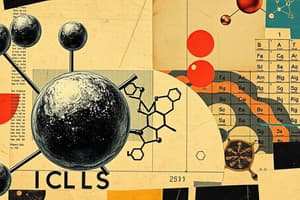Podcast
Questions and Answers
What is the smallest unit of an element that retains the chemical properties of that element?
What is the smallest unit of an element that retains the chemical properties of that element?
- Proton
- Atom (correct)
- Molecule
- Neutron
Where are protons and neutrons found in an atom?
Where are protons and neutrons found in an atom?
- Inside the nucleus (correct)
- Orbiting around the nucleus
- Bonded to other atoms
- In the valence shell
What is responsible for the atom's chemical bonding behavior?
What is responsible for the atom's chemical bonding behavior?
- Neutrons
- Valence shell (correct)
- Nucleus
- Electron orbit
What determines the identity of an element?
What determines the identity of an element?
What are isotopes?
What are isotopes?
Which subatomic particle is responsible for the variation in atomic masses of isotopes?
Which subatomic particle is responsible for the variation in atomic masses of isotopes?
What is the sum of protons and neutrons in an atom called?
What is the sum of protons and neutrons in an atom called?
What is the average mass of all isotopes of an element called?
What is the average mass of all isotopes of an element called?
Which is the most abundant isotope of carbon?
Which is the most abundant isotope of carbon?
What type of bond is formed when atoms share electrons to form a molecule?
What type of bond is formed when atoms share electrons to form a molecule?
How do ionic bonds form?
How do ionic bonds form?
What happens to an atom when it loses an electron and becomes positively charged?
What happens to an atom when it loses an electron and becomes positively charged?
What is the primary factor that determines whether an atom will form an ionic or covalent bond?
What is the primary factor that determines whether an atom will form an ionic or covalent bond?
What does the sharing of electrons in a covalent bond allow atoms to achieve?
What does the sharing of electrons in a covalent bond allow atoms to achieve?
What are the building blocks of matter?
What are the building blocks of matter?
What determines the identity of an element?
What determines the identity of an element?
Flashcards are hidden until you start studying
Study Notes
Atom and Molecules: Understanding the Building Blocks of Matter
Atoms and molecules are the basic building blocks of matter. An atom is the smallest unit of an element that retains the chemical properties of that element. Molecules, on the other hand, are composed of two or more atoms of the same element or different elements bonded together. In this article, we will explore the atomic structure and the formation of molecules.
Atomic Structure
Atoms are composed of protons, neutrons, and electrons. Protons and neutrons are found in the nucleus of an atom, while electrons orbit around the nucleus. The number of protons in an atom determines the element's identity. For example, an atom with one proton is hydrogen, with two protons it is helium, and so on. Neutrons have no charge, making them neutral particles. The mass of an atom is essentially the sum of protons and neutrons, and the atomic number is the number of protons.
The outermost shell of an atom, the valence shell, is where the electrons that determine the chemical properties of an atom are found. The electrons in the valence shell are responsible for the atom's chemical bonding behavior.
Isotopes and Atomic Mass
Isotopes are atoms of the same element that have the same number of protons but different numbers of neutrons. Isotopes have the same chemical properties but different atomic masses due to the variation in the number of neutrons.
The atomic mass of an element is the average mass of all its isotopes, including their relative abundance. For example, carbon has three naturally occurring isotopes: carbon-12, carbon-13, and carbon-14. Carbon-12 has 6 neutrons, while carbon-13 has 7 neutrons, and carbon-14 has 8 neutrons. The relative abundance of these isotopes is 99%, 1%, and 1 in a trillion, respectively.
Formation of Molecules
Molecules are formed when atoms bond together. There are two primary types of bonds: ionic and covalent. Ionic bonds occur when atoms transfer electrons, creating a positive ion and a negative ion. Covalent bonds occur when atoms share electrons, forming a molecule.
Ionic Bonds
Ionic bonds form when an atom loses an electron and becomes a positive ion, and another atom gains that electron and becomes a negative ion. These oppositely charged ions are attracted to each other, forming an ionic bond.
Covalent Bonds
Covalent bonds form when atoms share one or more pairs of electrons. This sharing of electrons creates a stable molecule. The sharing of electrons allows atoms to achieve a stable electron configuration, which is the lowest energy state. This process is called electron pairing.
Summary
Atoms and molecules are the building blocks of matter. Atoms are composed of protons, neutrons, and electrons, with the atomic structure determining the element's identity. Molecules are formed when atoms bond together, either through ionic bonds or covalent bonds. Understanding the atomic structure and the formation of molecules is crucial for understanding the behavior of matter and the properties of elements.
Studying That Suits You
Use AI to generate personalized quizzes and flashcards to suit your learning preferences.




